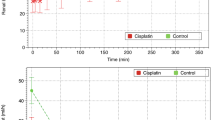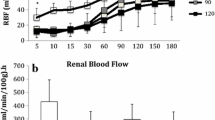Summary
Kidneys were perfused either with Euro-Collinssolution or with HTK-solution of Bretschneider. The perfusion pressure as well as the perfusion flow were measured during a six-minute perfusion. The perfusion resistance was higher in Euro-Collins-kidneys than during HTK-perfusion. The venous outflow of the kidney as well as the ureteral outflow was measured during each minute of the perfusion and has analysed for osmolality, and for sodium and potassium concentrations. In Euro-Collins-kidneys a complete “equilibration” of the extracellular space was not achieved, while during HTK-perfusion concentrations in the venous as in the tubular outflow, similar to those in the HTK-solution itself, could be reached. At the end of the different perfusions, tissue was analysed for biochemical parameters such as ATP, ADP, AMP and lactate as well as for morphological features. Lactate had increased and ATP had decreased during perfusion with Euro-Collins-solution, while ATP had not changed and lactate had decreased during perfusion with HTK-solution. Normal glomerular, tubular and dilated vascular structures can be seen after HTK-perfusion, while a glomerular and vascular contraction takes place during Euro-Collins-perfusion.
Similar content being viewed by others
References
Andrews PM, Coffey AK (1982) Factors that improve the preservation of nephron morphology during cold storage. Lab Invest 46:100–120
Belzer FO, Ashby BS, Dunphy JE (1967) Twenty-four hour and 72-hour preservation of canine kidneys. Lancet II:536
Bergstrom J, Collste H, Groth C, Hultman E, Melin B (1971) Water, electrolyte and metabolite content in cortical tissue from dog kidneys preserved by hypothermia. Proc Eur Dial Transplant Assoc VIII:313–321
Bretschneider HJ (1964) Überlebenszeit und Wiederbelebungszeit des Herzens bei Normo- und Hypothermie. Verh Dtsch Ges Herz-Kreislaufforsch 30:11–34
Bretschneider HJ, Hübner G, Knoll D, Lohr B, Nordbeck H, Spieckermann PG (1975) Myocardial resistance and tolerance to ischemia: Physiological and biochemical basis. J Cardiovasc Surg 16:241–260
Bretschneider HJ (1980) Myocardial protection. Thorac Cardiovasc Surg 28:295–302
Bretschneider HJ, Gebhard MM, Preusse CJ (1984) Cardioplegia. Principles and problems. In: Sperelakis N (ed) Physiology and pathophysiology of the heart. Martinus Nijhoff, Boston, pp 605–616
Coffey AK, Andrews PM (1983) Ultrastructure of kidney preservation: varying the amount of an effective osmotic agent in isotonic and hypertonic preservation solution. Transplantation 35:136–143
Collins GM, Bravo-Shugarman M, Terasaki PD (1969) Kidney preservation for transportation. Lancet II:1219–1222
Deetjen P, Kramer K (1961) Die Abhängigkeit des O2-Verbrauches der Niere von der Na+-Rückresorption. Pfluegers Arch 273:636–650
Downes G, Hoffmann R, Huang J, Belzer FO (1973) Mechanism of action of washout solutions for kidney preservation. Transplantation 16:46–53
Fleckenstein-Grün G, Fleckenstein A (1980) Calcium-Antagonismus, ein Grundprinzip der Vasodilatation. In: Fleckenstein A, Roskamm H (Hrsg), Calcium-Antagonismus, Springer, Berlin Heidelberg New York
Flores J, Dibona DR, Beck CH, Leaf A (1972) The role of cell swelling in ischemic renal damage and the protective effect of hypertonic solute. J Clin Invest 51:118–126
Gerlach E, Bader W, Schwoerer W (1961) Über den Stoffwechsel säurelöslicher Phosphorverbindungen in der Rattenniere. Pfluegers Arch 272:407
Greger R (1985) Ion transport mechnism in thick ascending limb of Henle's loop of mammalian nephron. Physiol Rev 65: 760–797
Guder WG, Wirtensohn G (1981) Renal turnover of substrates. In: Greger R, Lang F, Silbernagel S (eds) Renal transport of organic substances. Springer, Berlin Heidelberg New York
Günther R, Silbernagel St (1981) Renal handling of L-Histidine studied by continuous microperfusion and free flow micropuncture in the rat. Pfluegers Arch 389:137–142
Gutmann J, Wahlefeld AW (1974) L-(+)-Lactat, Bestimmung mit Lactat-Dehydrogenase und NAD. In: Bergmeyer HU (Hrsg) Methoden der enzymatischen Analyse, Aufl 3, Bd II. Chemie Verlag, Weinheim, S 1510–1514
Hargitay B, Kuhn W (1951) Das Multiplikationsprinzip als Grundlage der Harnkonzentrierung in der Niere. Z Elektrochemie 55:539–558
Jamison RL, Bennett CM, Berliner RW (1967) Countercurrent multiplication by the thin loops of Henle. Am J Physiol 212: 357–366
Kallerhoff M, Hölscher M, Kläß G, Bretschneider HJ (1981) The equilibration proceedings at a 12′ long perfusion of kidneys with HTP-solution of Bretschneider. Pfluegers Arch 389: R43
Kallerhoff M, Hölscher M, Kehrer G, Kläß G, Bretschneider HJ (1985) Effects of preservation conditions and temperature on tissue acidification in canine kidneys. Transplantation 39: 485–489
Kallerhoff M, Kehrer G, Siekmann W, Blech M, Gebhard MM, Helmchen U, Bretschneider HJ (1985) Experimentelle Anwendung der kardioplegischen Lösung HTK nach Bretschneider für eine in-situ-Protektion von Nieren. In: Harzmann R (Hrsg) Experimentelle Urologie, Springer, Berlin Heidelberg New York, S 180–188
Kallerhoff M, Blech M, Kehrer G, Kleinert H, Schnabel PhA, Siekmann W, Helmchen U, Bretschneider HJ (1985) A new method for perfusion fixation of dog kidneys. Pfluegers Arch 405 (Suppl 2):R33
Kallerhoff M, Blech M, Kehrer G, Kleinert H, Siekmann W, Helmchen U, Bretschneider HJ (1986) Postischemic renal function after kidney protection with the HTK-solution of Bretschneider. Urol Res 14:271–278
Kehrer G, Gebhard MM, Kallerhoff M, Siekmann W, Blech M, Helmchen U, Bretschneider HJ (1984) The influence of glucose premedication on perfusion resistance, perfusional diuresis, and equilibration of the dog kidney during perfusion with Bretschneider's cardioplegic solution HTK in standardized anaesthesia. Pfluegers Arch 400:R22
Kehrer G, Kallerhoff M, Probst R, Siekmann W, Blech M, Bretschneider HJ, Helmchen U (1985) Construction and experimental application of a catheter for selective arterial kidney perfusion in situ. Urol Res 13:85–89
Kehrer G, Blech M, Kallerhoff M, Kleinert H, Bretschneider HJ (1985) Influence of preischemic perfusion resistance on postischemic renal function. Pfluegers Arch 405:R33
Kokko JP, Rector FC (1972) Countercurrent multiplication system without active transport in inner medulla. Kidney Int 2:214–223
Kramer K, Thurau K, Deetjen P (1960) Hämodynamik des Nierenmarks. I. Mitteilung. Capillare Passagezeit, Blutvolumen, Durchblutung, Gewebehämatocrit und O2-Verbrauch des Nierenmarks in situ. Pfluegers Arch 270:251–269
Kuhn W, Ryffel K (1942) Herstellung konzentrierter Lösungen aus verdünnten durch bloße Membranwirkung. Hoppe Seylers Z Physiol Chem 276:145–178
Leaf A (1970) Regulation of intracellular fluid volume and disease. Am J Med 49:291
Levinsky NG, Berliner RW (1959) The role of urea in the urine concentrating mechanism. J Clin Invest 38:741–748
Levy MN (1959) Oxygen consumption and blood flow in the hypothermic perfused kidney. Am J Physiol 197:1111
Mason J, Beck F, Dörge A, Rick R, Thurau K (1981) Intracellular electrolyte composition following renal ischemia. Kidney Int 20:61
Pfaller W (1981) Morphologic analysis of tubular transport. In: Greger R, Lang F, Silbernagel S (eds) Renal transport of organic substances. Springer, Berlin Heidelberg New York
Preusse CJ, Gebhard MM, Bretschneider HJ (1981) Myocardial “Equilibration Processes” and myocardial energy turnover during initiation of artificial cardiac arrest with cardioplegic solution-Reasons for a sufficiently long cardioplegic perfusion. Thorac Cardiovasc Surg 29:71–76
Ruedas G (1980) Changes in flow resistance in kidney vessels of dogs by hypothermic hyperosmotic perfusion. Urol Int 35:81–90
Sacks SA, Petritsch PH, Kaufmann JJ (1973) Canine kidney preservation using a new perfusate. Lancet II:1024–1028
Siekmann W, Blech M, Kallerhoff M, Kehrer G, Kleinert H, Bretschneider HJ, Helmchen U (1985) Morphologische Befunde nach zweistündiger kompletter Nierenischämie unter Anwendung verschiedener Protektionsverfahren. Verh Dtsch Ges Pathol 69:612
Silbernage S (1981) Renal transport of amino acids and oligopeptides. In: Greger R, Lang F, Silbernagel S (eds) Renal transport of organic substances. Springer, Berlin Heidelberg New York, pp 93–117
Southard JH, Rice MJ, Ammetani MS, Belzer FO (1985) Effects of short-term hypothermic perfusion and cold storage on function of the isolated-perfusion dog kidney. Cryobiology 22:147–155
Thorn W, Heimann J, Müldener B, Gereken G (1957) Beitrag zum Stoffwechsel von Leber, Niere, Herz und Skelettmuskulatur in Asphyxie, Anoxie und bei Hypothermie. Pfluegers Arch 265:34–54
Ullrich KJ, Drenckhahn FO, Jaransch KH (1955) Untersuchungen zum Problem der Harnkonzentrierung und-verdünnung. Über das osmotische Verhalten von Nierenzellen und die begleitende Elektrolytanhäufung in Nierengewebe bei verschiedenen Diuresezuständen. Arch Ges Physiol 261:62–77
Wesson LG, Colburg JE, DeGutman A, Elsasser W, Dunn St (1979) Extracellular fluid of the kidney preserved by the Collins technique. Transplantation 27:380–383
Wirz H (1953) Der osmotische Druck des Blutes in der Nierenpapille. Helv Physiol Acta 11:20–29
Author information
Authors and Affiliations
Additional information
Supported by the Deutsche Forschungsgemeinschaft, SFB 89-Kardiologie Göttingen
Rights and permissions
About this article
Cite this article
Kallerhoff, M., Blech, M., Kehrer, G. et al. Short-term perfusion and “Equilibration” of canine kidneys with protective solutions. Urol. Res. 15, 5–12 (1987). https://doi.org/10.1007/BF00256327
Accepted:
Issue Date:
DOI: https://doi.org/10.1007/BF00256327




